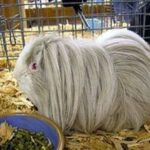The guinea pig, also known as the cavy, is a species of rodent native to South America that has become extremely popular as a household pet. Their docile nature and low maintenance lifestyle had made them an ideal pet for many people and families. But, as with any creature, guinea pig’s can suffer from irritating skin conditions that may leave a pet owner itching to get to the root of the problem.
Skin problems in guinea pigs can result from a multitude of factors including, but not limited to, scurvy (vitamin C deficiency), barbering (pulling out of the hair by an individual or fellow cage mates), cystic ovaries, bumble foot (skin infection of the foot), greasy seborrhea (excessive gland secretion leading to matted coats), allergies, abscesses, and even tumors. The most common culprits of skin problems in guinea pigs just happen to be parasites. Parasitic infestations are far more common among these types of pets than fungal infections.
FLEAS:
The parasites that cause the most common and irritating skin conditions are fleas, mites, and lice. The cat flea (Ctrenocephalides felis) is the peskiest of the parasites when it comes to guinea pigs. An infestation of these creatures can result in severe scratching, hair loss known as alopecia, lesions on the skin, and even anemia in cases where there is a high volume of fleas. Treatment can range from the use of medicated shampoos to the administration of oral medication to ward off and eliminate these annoying pests.
MITES:
There are two types of mites that are bothersome to guinea pigs: Trixacarus caviae (most common) and Chirodiscoidae caviae. T. caviae typically affects the head, shoulder, back, and flank regions while C. caviae is primarily found in the rump area. T. caviae burrows into the skin and as such causes severe scratching, hair loss, thickening of the skin, redness of the skin, and the formation of solid bumps on the skin. C. caviae is less common but resides on the hair rather than burrowing beneath the skin. This particular mite causes severe scratching, redness of the skin, hair loss, flaking, and skin ulcers that result from excessive grooming.
T. caviae is diagnosed by a veterinarian through skin scrapings while C. caviae can be detected by simply examining hairs under a microscope. In either case treatment is the same and typically involves ivermectin injections. Ivermectin is a medication used to treat a large number of parasitic infections. It is important that your guinea pig’s housing be cleaned thoroughly and disinfected once treatment has begun to prevent a re-infestation.
LICE:
Another parasitic creature that may infect your pet guinea pig is commonly known as lice. There are several different species that may plague your pet but fortunately these species of lice are not transmittable to human beings unlike fleas and mites. Lice commonly affect the head and ears causing excessive scratching, redness of the skin, the formation of bumps on the skin, and scabs. Treatment is typically the same as that of mites.
Less common but still a potential contributor to skin problems in guinea pigs are fungal infections. Ringworm is the most common fungal infection that affects guinea pigs and is similar in nature to the fungus that causes athlete’s foot. Young guinea pigs are more susceptible to ringworm and symptoms typically include patchy hair loss and flaking of the skin.
RINGWORM:
Ringworm can be transmitted to other pets and to humans so avoid handling an infected pet if at all possible. If you must handle a pet that has been diagnosed with a ringworm infection wear pet-safe, disposable gloves (ask your veterinarian) and/ or thoroughly wash your hands and forearms afterwards. Treatment of ringworm involves the administration of topical or oral anti-fungal medications and may also include bathing with medicated shampoos.
If you suspect your guinea pig is suffering from a skin condition consult with your veterinarian immediately regarding diagnosis and treatment. Skin problems can be a nuisance and quite uncomfortable for your pet. Immediate alleviation of the irritating problem will bring your guinea pig great relief. As always I wish you and your pet the best in health and happiness.
Sources:
www.peteducation.com/article.cfm?cls=18&cat;=1800&articleid;=2998
www.animalhospitals-usa.com/small_pets/guinea_pig_diseases_parasitic.html
www.petalia.com.au/template/storytemplate_process.cfm?specie=Small_Pets&story;_no=2077





